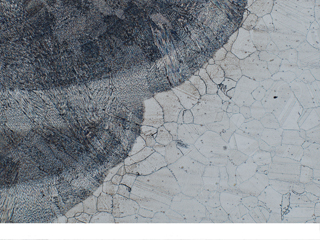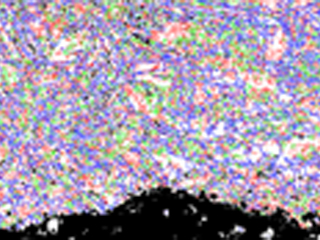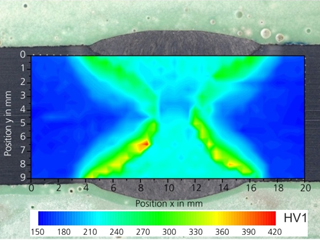Welded joints: Evaluation and lifetime concepts
What we can do for you
We develop solutions which enable you to improve welding processes in your applications. Additionally, we support you in evaluating welded joints: was the welding done correctly? Did any cavities, pores or welding mistakes occur and/or was the welding incomplete? Did you create unwanted residual stresses?
During operation we evaluate a joint’s safety and life expectancy, especially for high temperature applications. We also consider the extreme environment of power plants, including aggressive atmospheres and changing temperatures.
We rely on our broad range of know-how to answer our clients’ questions. We simulate the welding process in order to calculate the resulting structure and residual stresses. Subsequently, we develop procedures to reduce the component’s warping. We optimize post weld heat treatments to prolong the components’ working life. Using a detailed mechanical characterization under conditions similar to operation we can define weld strenght reduction factors, especially for high temperatures. Furthermore, we can determine the remaining lifetime of cracked welded joints. Our expertise is also useful in evaluating joints between different metals: our clients gain vital information and solutions for the improvement of their joining processes, thus prolonging the components’ working life.

Analyses
- Microstructure and damage analysis: evaluation of the micro structure via light microscopy, REM, EDX, XRD, chemical analysis using GDOES, determination of local strength and strength distribution via hardness mappings and fracture analyses.
- residual stress measurements in the lab and on site
- hydrogen analyses: measuring of hydrogen content via heat extraction method and thermal desorption spectroscopy (TDS), determination of characteristic values for hydrogen diffusion via permeation tests
- determination of degradation mechanisms
- isothermal and thermocyclic endurance tests and operation-like creep-fatigue tests as well as cyclic crack growth rates on cross-weld samples, samples from a welding simulator and samples from the weld metal to:
- Evaluate the life time of welded joints (determination of weld strenght reduction factors)
- Evaluate the fracture growth in welded joints
- Examine the influence of welding defects (such as hot cracks) on life expectancy
- Examine the influence and change of residual stresses, microstructure and mechanical properties
- Optical fracture tracking and strain measurement for improved evaluation of cross-weld samples
- Examinations of relaxation cracks via SSRT (slow strain rate tests) and deduction of appropriate heat treatments

Evaluations
- Determination of relevant damage mechanisms
- Evaluation of welding parameters under consideration of the evolved microstructure and the respective properties
- Lifetime analyses
- Leak-before-break and (remaining) lifetime evaluation of crack containing components and their welded joints under operation-like stress/load

Simulations
- Simulation of precipitation kinetics during the welding process, during heat treatment and during operation as well as their effect on the life time at elevated temperatures
- Welding and heat treatment simulations: microstructure, hardness, residual stresses and distortions
- Cold crack simulation: simulation of hydrogen diffusion during welding under consideration of microstructure, residual stresses, plastic strain and hydrogen traps
- Simulation of distortion and lifetime of components (including their welded joints) under thermocyclic creep fatigue
- Evaluation of the remaining lifetime of crack containing components (including their welded joints) via a lifetime prognosis tool
 Fraunhofer Institute for Mechanics of Materials IWM
Fraunhofer Institute for Mechanics of Materials IWM
